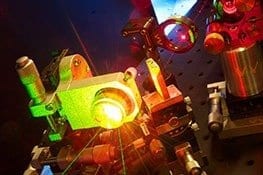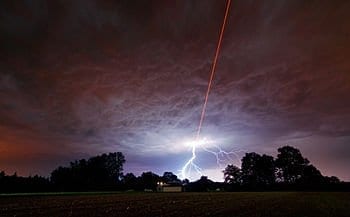
Once a James Bond fantasy, diamond-based lasers are now becoming a reality.
Ground-breaking research is harnessing the unique properties of diamonds to develop a new generation of lasers that could lead to many benefits, from better treatment of skin complaints and diabetes-related eye conditions to improved pollution monitoring and aeronautical engineering.
A University of Strathclyde team has developed a new type of high-performance, ultra-versatile Raman laser* that harnesses diamonds to produce light beams with more power and a wider range of colours than current Raman lasers. These capabilities could open up important new applications. The research is funded by the Engineering and Physical Sciences Research Council (EPSRC).
Although researchers in Australia are also working on innovative diamond-based Raman laser technology, the Strathclyde team has achieved two major world firsts:
- The first ever ‘tunable’ diamond Raman lasers, where the colour of the light can be adjusted to meet specific needs (e.g. the treatment of vascular lesions** requires a yellow/orange light that is difficult to produce with conventional lasers but which is needed to maximise absorption by the lesion while minimising damage to surrounding tissue). Underpinning this breakthrough is the fact that diamond’s optical properties enable diamond lasers to produce a range of colours that are hard to generate by conventional means. For example, yellow/orange light which can be used in medicine in the treatment of conditions such as vascular lesions or retinal bleeding of blood vessels at the back of the eyes.
- The first ever continuously operating diamond Raman laser. This is important because lasers that can only provide short pulses of light are unsuited to some medical and other applications (e.g. where pulses would damage delicate structures in the eye). In medical treatment for highly sensitive areas therefore, there are situations where using a pulsed laser would create too much acoustic disturbance.
Professor Martin Dawson, who initiated and oversaw the project at the University of Strathclyde’s Institute of Photonics, says: “Our new lasers can generate light ranging from the lower end of the ultra-violet part of the electromagnetic spectrum, right through the visible part, up to the middle of the infra-red region. That means they can plug many of the existing gaps in lasers’ capabilities.”
The silicon and other materials conventionally used in Raman lasers to change the colour of light are limited by the power of the laser and the range of colours they can produce, due to the materials’ physical properties. For instance, their relatively limited ability to conduct heat restricts the amount of laser output that can be generated, while their particular optical properties limit their ability to generate certain useful colours of light. By contrast, diamond has unrivalled thermal conductivity which, combined with its unique strength, rigidity and optical properties, make it ideal for use in lasers.
Dr Alan Kemp of the University of Strathclyde, who was Principal Investigator on the project, says: “Exploiting single-crystal diamonds directly in lasers opens up a world of possibilities. A key benefit is that you don’t need a big crystal to generate the power you require, so you can make lasers much smaller. Conventional Raman lasers have to incorporate a crystal 3-6 centimetres long. But our new lasers can produce the same amount of power with a diamond crystal just 2-6 millimetres long. That means lasers could be deployed in confined spaces where they currently simply can’t go – such as in aeronautical applications and medicine where high-power lasers of particular colours are required but space is at a premium.”
The Latest Bing News on:
Diamond Raman laser
- Heeramandi Director Sanjay Leela Bhansali Wanted To Cast Pakistani Actors Fawad Khan-Mahira Khan But...on May 1, 2024 at 7:33 am
The Diamond Bazaar is garnering praise on Netflix. During an interview in Los Angeles, Bhansali disclosed his initial plan to cast Fawad Khan and Mahira Khan but explained why it didn't materialise.
- Ivory-scanning lasers used to illuminate the illegal elephant in the roomon April 29, 2024 at 5:00 pm
That's where the lasers come in. Led by the University of Bristol's Dr. Rebecca Shepherd, scientists from that institution and the University of Lancaster set out to see if a non-destructive technique ...
- New laser tech using Raman spectroscopy detects illegal elephant ivoryon April 25, 2024 at 11:23 am
They developed a laser-based approach employing Raman spectroscopy to distinguish the chemistry of mammoth and elephant ivory precisely. Scientists at the Universities of Bristol and Lancaster noted ...
- Laser Hackson April 23, 2024 at 7:02 pm
Lasers are pretty much magic — it’s all done with mirrors. Not every laser, of course, but in the 1980s, the most common lasers in commercial applications were probably the helium-neon laser ...
- We Tested the Best Laser Measures for DIYers and Proson April 11, 2024 at 1:53 am
Stay tuned for our 2024 updates. Laser distance measures use a laser and an optical sensor to determine the distance between two surfaces to find the height of a room, the length of a stairway ...
- Best laser printers in 2024on April 9, 2024 at 4:34 pm
The best laser printers on the market are the ones that consistently deliver pages of high quality at lower printing costs. The fact that they often deliver those pages at a cheaper price than ...
- Inkjet vs. laser: What’s the difference, and which is best?on April 6, 2024 at 5:00 pm
Along with navigating all the different brands, you’ll also need to figure out if an inkjet or laser printer is best for your needs. Both of these printer types are perfectly acceptable options ...
- Inkjet vs. Laser: Which printer is right for you?on April 3, 2024 at 2:09 pm
Inkjet vs laser printers: Which one is right for you? This is the most basic and most essential question in printer shopping. You've no doubt wondered what differentiates the two technologies and ...
- Synthetic diamond – secret facets for endless possibilitieson March 25, 2021 at 6:28 am
have made monolithic diamond Raman lasers a commercial reality, allowing the generation of wavelengths not easily available with existing technology. In the realm of quantum applications ...
- Silicon Raman Laser using Photonic Crystal Nanocavityon July 11, 2019 at 9:41 pm
Using the nanocavities, I will achieve silicon Raman lasers with small sizes and low thresholds, which have many advantages such as the low energy consumption, dense integration, CMOS compatibility, ...
The Latest Google Headlines on:
Diamond Raman laser
[google_news title=”” keyword=”Diamond Raman laser” num_posts=”10″ blurb_length=”0″ show_thumb=”left”]
The Latest Bing News on:
Diamond-based lasers
- High-intensity spatial-mode steerable frequency up-converter toward on-chip integrationon May 1, 2024 at 1:13 pm
Electronic Science discusses high-intensity spatial-mode steerable frequency up-converter toward on-chip integration. Integrated photonic devices consisting of micro-lasers, amplifiers, ...
- Tractor-trailers with no one aboard? The future is near for self-driving trucks on US roadson April 29, 2024 at 3:05 am
Within three or four years, thousands of self-driving tractor-trailers are expected to travel on America’s public freeways. The goal is for the trucks, which can run nearly around the clock ...
- BREAKTHROUGH : Lightsolver Makes Ultrafast Laser Based Computerson April 27, 2024 at 5:00 pm
LightSolver, creator of a new laser-based computing paradigm, announced a breakthrough in quantum-inspired high-performance computing. Its LPU100 system unleashes the power of 100 lasers to solve the ...
- The British Navy Will Use Lasers To Zap Drones Out Of The Sky: Here's Howon April 26, 2024 at 8:46 am
While laser-based warfare may seem like something you'll find in a game like "Starfield," the reality is it's already here. Or at least it soon will be. The Royal Navy is just a few years away ...
- Pentagon can benefit from robust photonics infrastructure in Europeon April 23, 2024 at 5:00 pm
(Sgt. Timothy Valero/Marine Corps) A top priority for the U.S. Space Force is the resilience of U.S. satellite networks against foreign threats, such as China and Russia, including against ...
- Ultrafast laser specialist Lithium lands €2Mon April 23, 2024 at 7:08 am
Lithium Lasers, a startup company in northern Italy that is developing ultrashort pulse (USP) industrial lasers, says it has attracted €2 million in venture funding.
- Controlled laser drilling of microviason April 23, 2024 at 3:54 am
Lasers can drill through these structures with high throughput and micrometer precision. A measurement technique based on laser-induced breakdown spectroscopy (LIBS) is set to check the quality of ...
- Laser-based flight instrumentationon April 19, 2024 at 10:52 pm
Laser-based air data sensors offer great potential for flight safety and the reduction of fuel consumption. The warning of turbulence at cruising altitudes or the adaptive load reduction of aircraft ...
- ‘Magic wands’ for laser techon March 6, 2023 at 9:44 pm
In contrast, the NTT light-based technology runs at room temperature and can be coupled to an optical fibre, potentially enabling a single laser to ... the wafer using diamond blades.
- Laser Diamonds Ltd.on December 12, 2022 at 4:52 am
Money flow measures the relative buying and selling pressure on a stock, based on the value of trades made on an "uptick" in price and the value of trades made on a "downtick" in price.
The Latest Google Headlines on:
Diamond-based lasers
[google_news title=”” keyword=”diamond-based lasers” num_posts=”10″ blurb_length=”0″ show_thumb=”left”]










